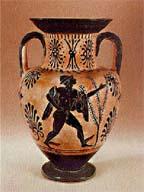
THIS BLACK-FIGURE VASE of the god Hermes is an example of the last remnants of the Etruscan society and the topic of the upcoming lecture at Wriston auditorium.
As North America’s oldest and largest organization devoted to archeology, the American Institute of Archaeology sponsors lectures in each of its local societies nationwide throughout the year. Appleton’s local society of AIA will welcome Ily Nagy to Lawrence University Oct. 27. Nagy will be presenting her lecture, “Eloquent Gifts: The Language and Use of Etruscan Terracotta Votives.”
Admittedly, the phrase “Etruscan vases” does not evoke an image of excitement and thrills in the mind of the average college student, but the lecture should prove to be fascinating and informative, especially to those interested in history, culture, or legend.
In the centuries before Roman rule, a people called the Etruscans settled in Italy between the Arno and Tiber rivers. Their nation, known as Etruria, flourished from 950 to 300 B.C.
The Etruscans were an intriguing group, fond of music, games, and racing. Their talents were numerous and included iron working, bronze working, artwork, and gold work. They also introduced the chariot to Italy.
The Etruscans were masters of the pottery wheel, famous especially for their black bucchero pottery.
As well as craftsmen, the Etruscans were a very religious people, creating strict religious laws and decorating the tombs of the dead like houses.
Unfortunately, experts know relatively little of the Etruscans. Little literature is left, their vocabulary is cryptic, and the Romans rarely mentioned the Etruscans in their own literature.
As a result, historians have gained most of their knowledge of the Etruscans from the remains of their buildings, monuments, and tombs, studying mostly sculptures or ceramics, such as the terracotta votives that Nagy will speak of.
Nagy’s lecture in Appleton will focus on terracotta dedications from Etruscan sanctuaries, discovered in sites in central Etruria. The relatively simple votives are representative of the devout worship of the Etruscans to their gods.
The votives vary in purpose and structure, with some resembling babies and others representing anatomical figures. Nagy will concentrate on large heads, “babies,” figures in enclosed structures, and miniature altars.
Nagy’s lectures, including “Eloquent Gifts,” are based on an ongoing decade of research on Etruscan artifacts.
Nagy is clearly an expert in her field, and has published numerous articles in various fields, primarily early Christian and Byzantine art, art and archaeology of Greece and Rome, and Etruscan archaeology.
Nagy now teaches at the University of Puget Sound in Washington, but she has held positions at Western Illinois University, the American Academy in Rome, and the Intercollegiate Center for Classical Studies in Rome.
She received her BA, MA, and PhD from UCLA.
Nagy currently presents three lectures through the American Institute of Archaeology: “Eloquent Gifts,” “Paris, Helen, and Menelaos: Reflections of the Saga in Etruscan Mirrors,” and “Etruscan Demons of the Underworld,” which she will present in Madison later in October.
Nagy will present “Eloquent Gifts: The Language and Use of Terracotta Votives” on Monday, Oct. 27 at 7:30 p.m. in the Wriston Auditorium.
